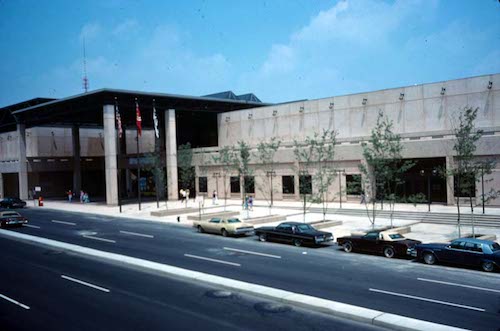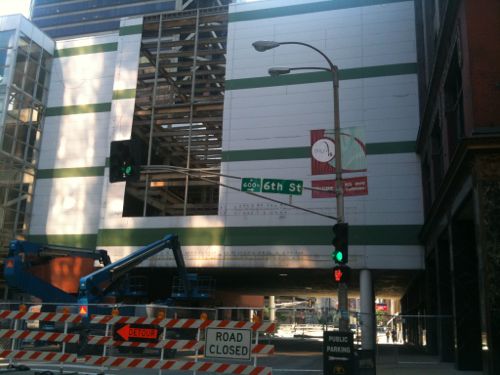March 17, 1978: Board of Aldermen Approve Downtown Shopping Mall Bills
In the 1970s civic leaders were busy destroying large swaths of downtown in order to retain/attract workers/employers & residents. In 1977 the Cervantes Convention Center opened with largely blank exterior walls and occupying 4 formerly separate city blocks.

The following Spring, 36 years ago today, they continued in the same direction advocated by our first planner Harland Bartholomew decades earlier:
The St. Louis Board of Aldermen approved three bills that would set the stage to develop a proposed downtown shopping mall, with the only further step being the acquisition of federal funding. The headquarters of Stx, Baer, & Fuller, which would become Dillard’s just months before the mall’s completion, and Famous-Barr existed with one block separating them between Washington and Locust at 6th Street. The goal was to create an enclosed, urban shopping mall with these two companies as anchors, and the estimated budget was nearly $150 million. St. Louis Centre opened in 1985 as the largest shopping mall in America. It had over 150 stores and 20 restaurants, and was initially a great success. Challenges appeared in the 1990s however, as the Westroads Shopping Center was redeveloped into the St. Louis Galleria and stores began closing. St. Louis Centre closed in 2006, and since then has been redeveloped into a 750-car parking garage and retail center. (STL250 on Facebook)
Seven years later the internally-focused mall opened. The pedestrian realm in St. Louis was officially dead.

In the 1970s big indoor shopping malls were all the rage. We know now in an urban setting, like a central business district, turning blank exterior walls to the sidewalk and putting all retail activity indoors out of view to people passing by is a formula for disaster. In hindsight, it’s obvious. At the time few realized the magnitude of the mistake.
When the Cervantes Convention Center was expanded a block to the south in the early 1990s it was given a new more inviting facade, controversial at the time. St. Louis Centre was converted into a large parking garage in this decade, with retail spaces facing outward to the sidewalk. Slowly we’re relearning that a CBD can’t appeal to the suburban motorist. The urban core of any region should distinguish itself from the suburbs.
Suburbia can’t match old urban neighborhoods, usually failing when it tries. Conversely, older urban areas fail when trying to be like new suburbs. Most people chose suburbia, I get that. In the St. Louis region we have plenty of suburbia for those who prefer it, we need to double-down on making the City of St. Louis the pedestrian-froendly urban environment preferred by the rest of us. These can co-exist in the same region. Unfortunately, we’ve gotten to the point of having so little good urban area that those seeking an urban life have had no other choice but to leave the region.
A few urban block here and there won’t support an urban life, we need a city 100% committed to the urban dweller.
— Steve Patterson
So I guess what this means then is that the new high-end Dierberg’s in Des Peres on Manchester, the one with the ginormous, windowless wall facing Manchester, ought to do just fine!
Vastly different context.
You’re missing my point. Des Peres is not trying to be a city: it’s being suburban, no windows and totally auto-centric!
Yes, that it is. Sadly, the Des Peres Dierberg’s is more pedestrian-frioendly than say the Schnuck’s on Arsenal.
I hadn’t seen a picture of the original Cervantes Convention Center – I like it, way more than the faux traditional face that’s on it now. It’s a box – why put lipstick on a pig? I’d much rather see honesty in architecture, and it was typical for its time and place, much like the old brick structures from the the first quarter of the 20th Century typified that era.
I agree – they should have kept the original facade
The 1993 addition was built on the block in front of this original facade. The only way to have kept the original facade would’ve been by not extending south to Washington Ave.
Steve,
it would be kind of neat to see a pic of the Washington Ave block at this same time…. if you come across one please post!
I wish I had photos before they built the addition. Here’s a 1971 aerial: http://www.historicaerials.com/aerials.php?scale=4.39752154956789E-6&lat=38.6314044947888&lon=-90.1914653137961&year=1971
I remember when they started talking about the mall downtown, I think I was still in highschool, the mall opened 12 years later. It was already looking like a bad idea, area was saturated with mall choices, why would anyone come from the county to a mall when one was already around the corner from where you lived that didn’t have the parking issues as downtown. My fondest memories are going downtown when I was a kid and later a teenager, we were like Chicago and New York, just on a smaller scale.
But why did Water Tower Place (opened 1976) succeed where St. Louis Centre and Union Station did not? Certainly the Chicago mall is in an “urban context.” Something is missing from this analysis.
Michigan Ave and Water Tower Place have active storefronts, not blank walls to the sidewalks.
Water Tower Place has big ol’ lobby windows on one side and blank walls on the other – parts of which have been given over to advertising for the stores that are inside on the upper floors. Next building over is the Hancock Tower, which has lousy street presence. In the other direction, there’s the historic water tower (or maybe the pumping station?), and then a big ugly Walgreen’s with a massive wall. Maybe it’s the case that foot traffic and the overall ambience of the Magnicent Mile are what sustained the giant vertical malls in Chicago, but I doubt it. Incredible numbers of people drive to Water Tower, and that was even more true in the 1980’s when Cabrini Green loomed just west of the el tracks. My point: I don’t think there was any “formula” for Chicago’s retail success, and I’m guessing that the failure of retail in St. Louis is a bigger story than just the errors in urban design here.
Yes, there are many reasons for retail failure here and retail failure success along Chicago’s “Magnificent Mile”, but design can’t be discounted.
Transit should be an important part of any discussion to support more viable or intense downtown uses: http://www.denver.org/metro/media/press-blog?bid=314